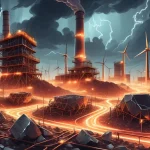Rare Earth Stock Surge: U.S.-China War Threatens Bitcoin Mining Hardware

Rare Earth Stocks Surge as U.S.-China Mineral War Threatens Crypto’s Core
The intensifying rivalry between the U.S. and China over rare earth minerals has propelled American mining stocks to staggering heights, driven by geopolitical friction and soaring demand for materials critical to tech, defense, and renewable energy. For the Bitcoin and broader crypto community, this isn’t a distant headline—it’s a glaring signal about the fragile physical foundations of our decentralized systems, from mining rigs to blockchain infrastructure.
- Market Boom: U.S. rare earth stocks like Critical Metals Corp have skyrocketed, with gains up to 241% in recent months.
- Power Struggle: China’s dominance over 60% of mining and 90% of processing clashes with U.S. bids for self-reliance.
- Crypto Risk: Supply disruptions could cripple hardware production for Bitcoin mining and decentralized tech, stalling innovation.
Rare earth minerals, a set of 17 lesser-known elements including neodymium, dysprosium, and lanthanum, are the unsung linchpins of modern technology. Far from mere dirt, these materials are refined into magnets, alloys, and components that power electric vehicle motors, military hardware, wind turbines, and the semiconductors driving our digital lives. In the crypto realm, they’re baked into the guts of Bitcoin mining rigs—those specialized ASIC (Application-Specific Integrated Circuit) machines crunching hashes—and the servers fueling Ethereum nodes or Web3 platforms. The International Energy Agency (IEA) projects a 50% surge in global demand for these minerals from 2024 to 2040, propelled by the shift to green energy, the electric vehicle explosion, and the relentless growth of data centers. That could mean annual needs climbing from hundreds of thousands of tons to well over a million, a jump that turns these obscure elements into a geopolitical battleground.
China’s Stranglehold and a Fragile Truce
China wields unparalleled control over this market, extracting 60% of the world’s rare earths and handling over 90% of the processing—transforming raw ore into usable forms like high-powered magnets or specialized powders. This isn’t just economic leverage; it’s a strategic chokehold. Earlier this year in April, Beijing ramped up export restrictions, rattling global supply chains and sparking shortages in critical sectors like defense and semiconductors. They upped the ante with plans for even tighter rules slated for November 9, mandating export licenses for rare earth products—a move that could’ve starved foreign industries. Following a high-stakes meeting in South Korea between U.S. President Donald Trump and Chinese President Xi Jinping, China delayed these harsher controls by a year. Don’t be fooled, though; this is no olive branch, just a brief reprieve in a simmering conflict. The specter of future cutoffs hangs heavy, a textbook case of centralized power weaponized on a global scale.
U.S. Counterattack Fuels Stock Market Frenzy
Meanwhile, the U.S. is racing to break free from this dependency, and investors are piling in with reckless abandon. Rare earth mining stocks have become Wall Street’s latest obsession, with Critical Metals Corp logging a mind-boggling 241% increase over the past three months, though the steam has started to fizzle recently. Energy Fuels has seen its stock quadruple in the first ten months of 2024, while NioCorp Developments mirrors that near-quadrupling, and Idaho Strategic Resources boasts gains exceeding 100% in the same window. This frenzy isn’t random; it’s stoked by U.S. government policies—grants, tax incentives, and rhetoric framing domestic mining as a national security imperative, as detailed in reports on the U.S.-China race for critical minerals dominance. Both the outgoing Biden administration and Trump’s incoming team have doubled down on slashing reliance on Chinese supply. But let’s cut the crap: a lot of this smells like pure hype. Are these investors banking on a new gold rush, or just shoveling money into glorified dirt? Speculative mania like this often ends with more busts than booms, and anyone with half a brain should be wary of betting the farm on unproven promises.
Tony Sage, CEO of Critical Metals, paints a grandiose picture of the moment, saying,
“I talk of it like this, I mean, there have been four big booms. You had the gold boom in the 19th century, the oil boom in the 20th century, in the early 21st century, you had the tech boom—and now you’ve got the rare earths boom.”
It’s a seductive narrative, and there’s no denying the seismic potential of rare earths to reshape industries. But history isn’t kind to unchecked optimism. Audun Martinsen, head of Supply Chain Research at Rystad Energy, warns of dangerous overconfidence. Many of these hyped-up firms are trading on future potential, not current output. Extracting ore is one hurdle; refining it into high-purity materials for industrial use is a costly, complex nightmare. Flash back to the 2010-2011 rare earth crisis—China slashed exports, prices soared by 500%, and countless startups betting on the surge crashed when the logistics didn’t add up. Today’s investors ignoring that lesson might as well be playing roulette with their portfolios.
The Crypto Connection: Hardware at Risk
For Bitcoin enthusiasts and crypto innovators, rare earths aren’t some abstract commodity—they’re the lifeblood of our hardware ecosystem. Those beefy ASIC miners that secure the Bitcoin network? They rely on rare earth-based magnets in cooling systems and trace elements in their hyper-efficient chips. The sprawling data centers running Ethereum’s proof-of-stake validators, decentralized finance platforms, or NFT marketplaces? Packed with semiconductors that can’t exist without these minerals. If supply chains seize up, the ripple effects could hit hard: skyrocketing costs for mining gear, delayed production of next-gen hardware, or bottlenecks in scaling blockchain infrastructure. Picture trying to expand Bitcoin’s Lightning Network for mass adoption while server shipments are stuck in limbo—that’s the kind of disruption we’re staring down.
This threat isn’t hypothetical. During the 2010 export squeeze, tech manufacturers faced component costs tripling almost overnight, with delivery times ballooning from weeks to months. A repeat scenario—or a failure of U.S. domestic production to scale—could kneecap crypto’s growth just as it could stall AI or green tech. Bitcoin maximalists might argue our network’s simplicity gives it an edge over altcoin ecosystems bogged down by hardware-intensive dApps or token minting. There’s some truth there; Bitcoin’s leaner demands could weather a shortage better than, say, Ethereum’s sprawling ambitions. But let’s not pretend we’re invincible. Miners still need rigs, rigs still need rare earths, and no amount of ideological purity changes that equation.
Decentralization’s Real-World Test
Stepping back, this mineral standoff between superpowers echoes the core battles we wage in the crypto space. China’s iron-fisted control over rare earths is a glaring example of why centralization is a ticking time bomb—be it a government hoarding critical resources or a legacy bank monopolizing money creation. Bitcoin was born to shatter that kind of concentrated power, to ensure no single entity can pull the plug on something essential. This geopolitical chess game drives home why decentralization isn’t just tech jargon; it’s a bulwark against dependency. For those of us pushing effective accelerationism, championing rapid tech progress, the rare earth saga is a call to build systems that can’t be throttled by any one player, whether they’re in Beijing or Washington.
That said, don’t buy into the U.S. narrative as some righteous fight for liberty. This scramble for rare earth self-sufficiency reeks of the same power and profit motives we critique in traditional finance. Trading one centralized giant for another isn’t progress—it’s just a new set of chains with a different flag. Doesn’t that sound like the halfway “decentralized” blockchain projects we call out, where VCs or core devs still hold the reins? If we’re hell-bent on upending the old order, we’ve got to skewer every ulterior agenda, not just the obvious villain’s. The Bitcoin ethos demands nothing less.
Boom or Bust: A Sobering Reality Check
I’m all for torching the status quo—that’s the beating heart of Bitcoin and crypto’s mission. But let’s not get drunk on rare earth fever. Not every company in this space will make it; many lack the tech, funding, or regulatory clearance to turn raw earth into real revenue. Mining is brutal enough, but processing? It’s a black hole of expense and expertise. Beyond the 2010 rare earth debacle, recall the dot-com bubble—hype outstripped reality, and the wreckage buried countless dreamers. Crypto OGs know this tune; we’ve seen ICO scams and rug pulls galore. As we push for innovation at breakneck speed, we can’t ditch skepticism. Back the future, sure, but don’t fall for get-rich-quick fairy tales, whether they’re peddled in mining stocks or shady altcoins. Balance isn’t just smart—it’s survival.
Key Questions and Takeaways on Rare Earths and Crypto
- What’s behind the rare earth stock explosion in the U.S.?
A volatile cocktail of U.S.-China rivalry, ballooning demand for tech and defense materials, and speculative bets amplified by government backing for domestic mining. - How does China keep its grip on the rare earth market?
By dominating 60% of global mining and over 90% of processing, using export curbs as a geopolitical lever to disrupt foreign supply chains. - Why do rare earth minerals matter to Bitcoin and crypto?
They’re integral to hardware like ASIC miners and data center servers, so supply hiccups could inflate costs or delay critical blockchain upgrades. - What dangers lurk in the rare earth investment craze?
Rampant overconfidence—many firms may collapse under technical or financial strain, mirroring past resource booms that fizzled into busts. - How does this superpower clash relate to decentralization?
China’s resource monopoly underscores the perils of centralized control, validating Bitcoin’s mission to build systems immune to single-point failures. - Are crypto players more vulnerable to supply shocks than other sectors?
Partially—while tech broadly suffers, Bitcoin’s lighter hardware footprint might endure better than altcoin networks reliant on complex setups for dApps or NFTs.
Looking at the full scope, this rare earth drama transcends stock tickers or trade wars; it’s a preview of how global dominance will be fought over in the decades ahead. The U.S. and China aren’t merely squabbling over minerals—they’re vying for mastery over the technologies that will shape tomorrow. For the crypto crowd, it’s a harsh nudge that even as we craft digital bastions of freedom through Bitcoin and blockchain, the tangible world still holds sway. Supply chains, hardware, and raw materials might lack glamour, but they’re the bedrock of our vision. If we’re truly about dismantling entrenched power, we must track who commands these fundamentals—because whoever does, steers the path forward. Let’s innovate with eyes wide open, ensuring our rebellion isn’t sunk by something as mundane as a shortage of dirt.



